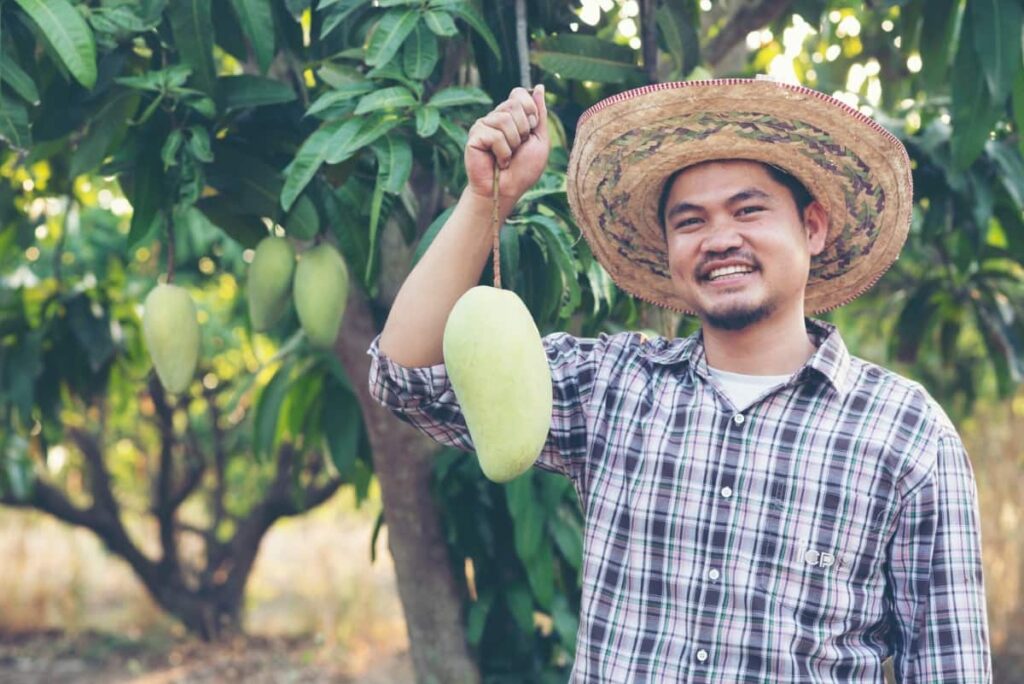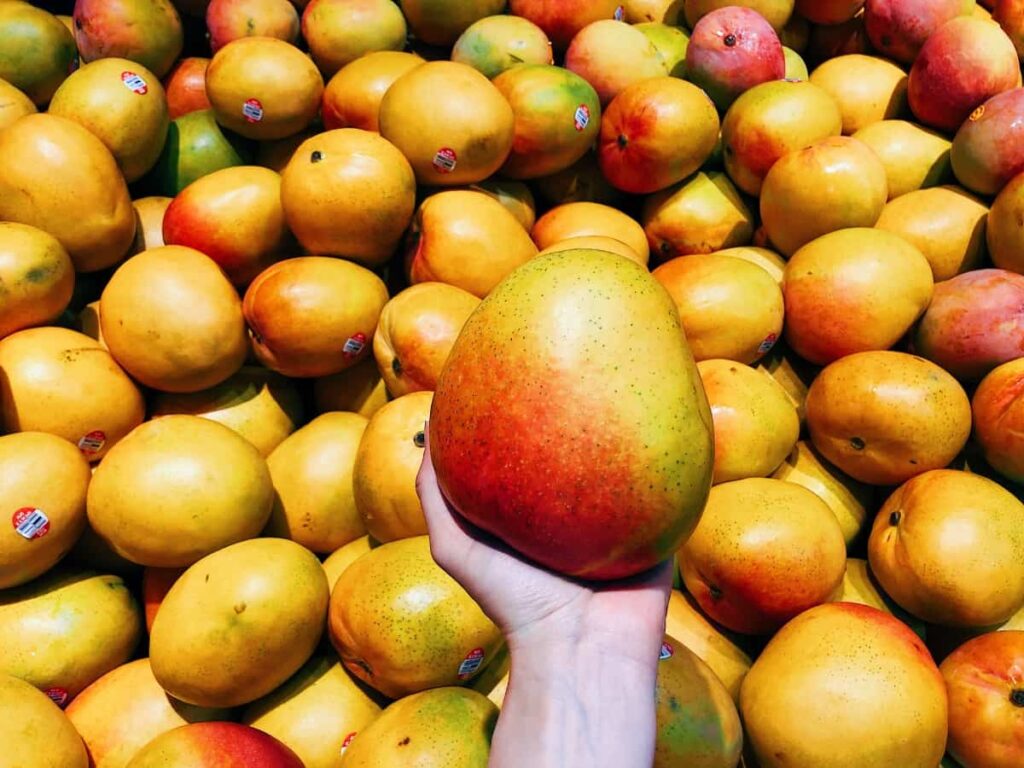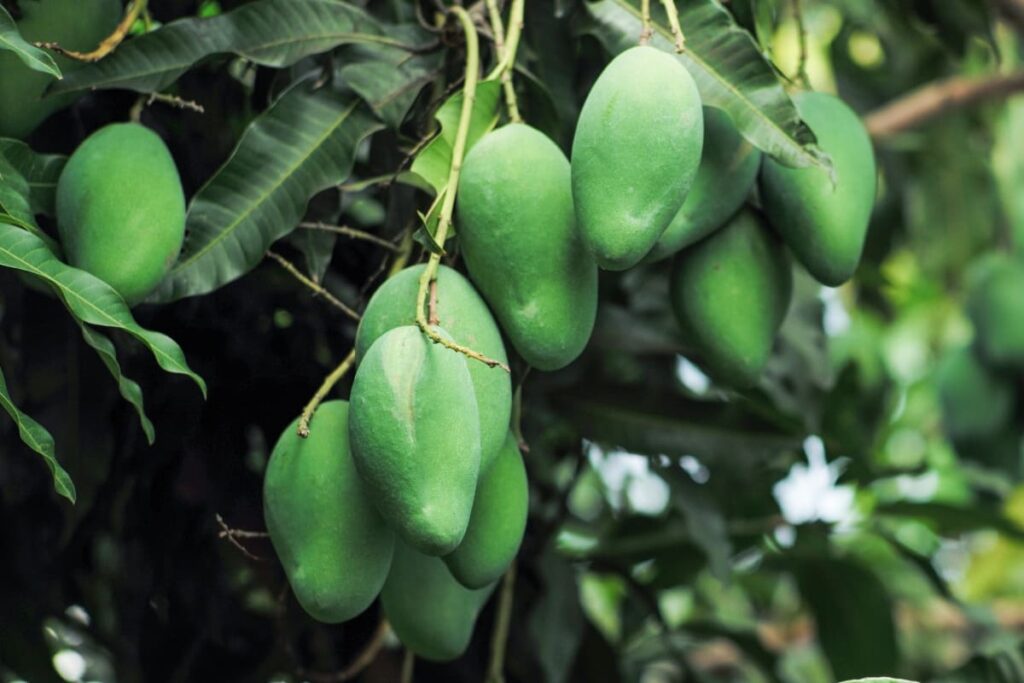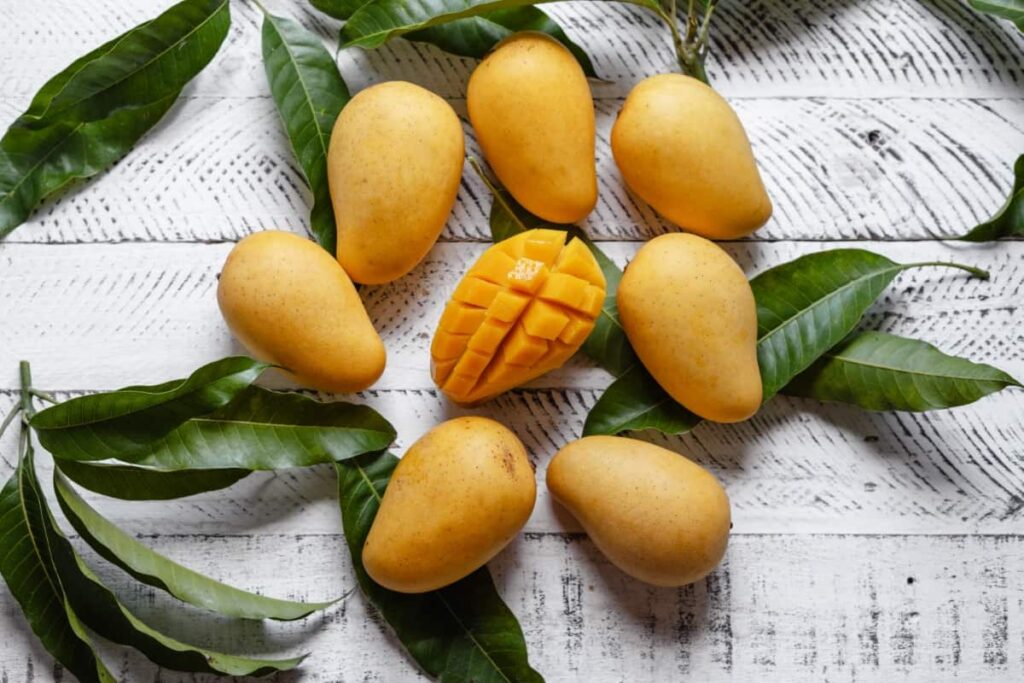Mango farming holds significant importance in Thailand, contributing greatly to the country’s agricultural sector. The tropical climate makes it ideal for Mango cultivation. With its rich history of Mango production, Thailand has developed expertise in growing high-quality varieties that are sought after both domestically and internationally.

Mango Farming in Thailand
Popular Mango Varieties in Thailand
Thailand is known for its wide range of Mango varieties, each with its unique flavor. Let’s explore some of the popular Mango varieties that thrive in this tropical paradise. The most important Mango variety in Thailand is the Nam Dok Mai. Its vibrant yellow skin and juicy flesh make it perfect for enjoying fresh or using in desserts.
Another popular variety is the Khiew Savoey, also known as “Green Sweet.” This Mango has a greenish-yellow skin with a tangy-sweet taste that balances perfectly between sour and sweet. For those who prefer a sweeter Mango, look no further than the Mahachanok. With its rich sweetness, this variety is often considered one of Thailand’s best-tasting Mangos.
Thailand Climate and Soil Requirements for Mango Cultivation
Thailand is known for its tropical climate, which provides an ideal environment for Mango cultivation. Mango trees require a temperature range of 25-35°C to grow and produce high-quality fruits. Thailand’s average annual temperature falls within this range, making it an excellent location for Mango farming.
In terms of soil requirements, well-drained sandy loam or loamy soils are preferred for Mango cultivation. Additionally, a pH level between 6-7 is considered ideal for optimum growth. Thailand benefits from various regions with suitable soil conditions for Mango farming.
Thai Mango Planting and Propagation Techniques
Farmers follow specific practices to propagate and plant Mango trees successfully in Thailand. The first step in the process is selecting healthy Mango seedlings or grafted plants from reliable nurseries. These seedlings should be disease-free and have a strong root system. Once selected, they are transplanted into prepared pits or containers filled with well-drained soil.
Planting usually takes place during the dry season when the risk of waterlogging is minimal. The ideal planting time for Mango farming in Thailand is between February and May when temperatures are warm, favoring root establishment. To promote optimal growth, farmers space the Mango trees at least 10-12 meters apart to allow sufficient air circulation and sunlight penetration.
After planting, farmers provide regular watering to help establish the young plants’ roots. They also apply organic fertilizers rich in nitrogen, phosphorus, and potassium (NPK), along with micronutrients necessary for balanced growth. Mango trees require consistent care during their early years.
Pruning and Training Mango Trees
By properly shaping and maintaining the trees, farmers can optimize their growth and maximize fruit production. The first step in pruning Mango trees is to remove any dead or diseased branches. Training young Mango trees involves selecting a central leader branch and removing competing branches to encourage upward growth. Proper tools should be used when pruning Mango trees to ensure clean cuts without causing unnecessary damage. Pruning shears or loppers are suitable for smaller branches, while a handsaw may be needed for larger ones.
In case you missed it: Mango Farming in Australia: Australian Mango Varieties to Grow from Seed to Harvest

Mango Season in Thailand
As the hot and humid climate sets in, Mango trees burst into a riot of colors, adorned with beautiful blossoms that eventually transform into luscious fruits. The Mango season in Thailand typically begins around March or April and extends till June or July. During this period, the markets are flooded with an abundance of mouthwatering Mangoes, each variety offering its unique flavor profile.
From the sweet and tangy Nam Dok Mai to the creamy and fragrant Khiew Nuab Khao, there is something for every palate. During peak season, you can find roadside stalls and local markets brimming with baskets filled with ripe Mangoes.
Irrigation and Water Management in Mango Orchards
Mango trees require an adequate supply of water throughout their growing season to ensure optimal growth and fruit production. In Thailand, where Mango farming is prevalent, farmers employ various irrigation techniques to meet the water requirements of their Mango trees. Drip irrigation systems are commonly used as they provide controlled and efficient watering directly to the roots.
Proper timing of irrigation is also important. Mango trees require more frequent watering during periods of active growth, especially during flowering and fruiting stages when they have higher water demands.
Mango Growing Regions in Thailand
The northern region, with its cooler climate and fertile soil, is known for producing high-quality Mangoes. Chiang Mai and Chiang Rai provinces are particularly renowned for their Mango orchards. Moving towards the northeastern region, Nakhon Ratchasima province stands out as a major hub for Mango cultivation. The favorable weather conditions and abundant water resources make it an ideal location for growing various Mango varieties.
In case you missed it: Best Fertilizer for Mango Trees: Organic, Natural, Homemade, NPK Ratio, and Schedule

In the southern region of Thailand, Surat Thani province takes the spotlight as one of the leading Mango-producing areas. Its warm tropical climate provides optimal conditions for the growth of succulent Mangoes that thrive in this region. Furthermore, other provinces like Rayong, Prachuap Khiri Khan, and Trat also contribute significantly to Thailand’s overall Mango production. These coastal regions benefit from both rich soil and proximity to export markets.
Mango Production Statics for Thailand
Mangoes are not just tropical fruits; they are an essential part of Thailand’s agricultural landscape. With its favorable climate and rich soil, Thailand has become the fourth-largest producer of Mangoes in the world. Annually, this fruit produces over 1.5 million metric tons of Mangoes.
Thailand’s Mango production is concentrated in three regions: the northern, northeastern, and southern areas. These regions provide ideal conditions for cultivating these delicious fruits. The warm temperatures and ample rainfall create the perfect environment for Mango trees to thrive.
Mango Farming Cost per Acre in Thailand
Mango farming in Thailand can be a lucrative venture for farmers, but it’s essential to understand the associated costs. The cost of Mango farming per acre in Thailand can vary depending on several factors. On average, farmers can expect to spend from 200,000 THB to 400,000 THB, with an average of around 300,000 THB.
Mango Farming Profit per Acre in Thailand
The profitability of Mango farming in Thailand can vary depending on a range of factors. One key factor that affects profit is the quality of the soil and water resources in the area. If these conditions are not met, it can impact the overall profitability of the farm. Another factor that influences profit is the choice of Mango varieties. In general, Mango farming in Thailand has the potential to generate a significant profit per acre per year. On average, farmers can expect to earn around 200,000 to 300,000 Thai Baht from each acre dedicated to Mango cultivation annually.
Mango Export Market and Opportunities in Thailand
Thailand’s Mango industry not only caters to the domestic market but also presents a lucrative export opportunity. With its prime location, favorable climate, and diverse Mango varieties, Thailand has become a major player in the global Mango market. The country enjoys a competitive advantage in terms of production volume and quality. Thai Mangoes are known for their exceptional taste, vibrant colors, and longer shelf life compared to other varieties.
This has allowed Thai farmers to tap into international markets and establish strong trade relationships with countries like China, Japan, South Korea, Europe, and the United States. The demand for Thai Mangoes continues to grow due to their unique flavors and superior quality. As a result, exporters have witnessed significant growth in sales volumes year after year.
Frequently Asked Questions (FAQ) on Mango Farming in Thailand
How Many Times Can a Mango Tree Bear Fruit Per Year?
Typically, once annually; however, late-blooming varieties or those grown under specific climatic conditions might produce two crops in a year.
Can I Grow Mangoes from Seeds?
Yes, however, it’s important to note that growing Mangos from seeds may result in variations compared to grafted or budded plants as they won’t retain all characteristics of their parent plant.
Do I Need to Use Fertilizers on My Mango Farm?
Yes, fertilizers can help provide essential nutrients that promote healthy growth and higher yields. Conducting soil tests will help determine which specific nutrients your farm may require.
In case you missed it: High Yield Hybrid Mango Varieties in India: State Wise Growing Guide

Conclusion
Mango farming in Thailand is an agricultural practice that involves the cultivation of Mango trees for their delicious and nutritious fruit. It is a major contributor to Thailand’s economy, as the country is one of the world’s largest producers of Mangoes. It plays a crucial role in providing livelihood opportunities for farmers, especially in rural areas.
- Aquaponic Farming at Home: A Step-By-Step Guide
- Profitable Village Farming Business Ideas in 2024
- High-Yield Aquaculture: Fast-Growing Fish for Farming
- Effective Fish Pond Construction Techniques for Beginners
- Irrigation and Water Management in Pineapple Farming
- Blossom to Harvest: Mastering Flowering and Pollination in Papaya Farming
- Pig Fattening Essentials: From Selection to Sale for Beginners
- Raising Wagyu Cattle: A Complete Guide for Premium Beef Production
- Soil Types and Their Water Holding Capacity
